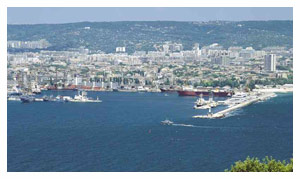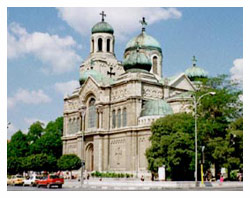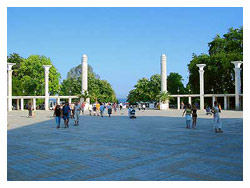
Varna is the third largest city in Bulgaria after Sofia and Plovdiv, with a population of 351,552(10.01.2006) . It is referred to as the sea capital or the summer capital of Bulgaria because it is the biggest city on the Bulgarian Black Sea Coast. Varna was also the base of the Bulgarian Navy. Currently, there is a Naval Museum with a museum ship torpedo boat Drazki. The archaeological museum contains some of the finds from the so-called "Gold of Varna", a cache of Chalcolithic grave-goods which are the oldest gold treasure in the world.
History The Ascension of Christ Cathedral in Varna
Varna was founded as an ancient Greek trading colony (apoikia), Odessos, about 580 BCE. Historically, Varna is perhaps best known for its eneolithic necropolis, which is the site of the oldest gold treasure to be found by archaeologists, the Gold of Varna. The Roman city had baths, built in the 2nd century CE, that are the largest Roman remains in Bulgaria.
 The city, control of which changed from Byzantine to Bulgarian numerous times during the Middle Ages, was captured by the Ottoman Empire in 1393. On November 10, 1444, the Battle of Varna was fought nearby, with the Turks defeating an army of 30,000 Crusaders led by Ladislaus III of Poland, which had assembled at the port to set sail to Constantinople. The army was attacked by a superior force of 120,000 Ottomans, led by sultan Murad II. Ladislaus III was killed in a bold attempt to capture the sultan, earning the nickname Varnenchik. The subsequent retreat of the crusader army made the fall of Constantinople all but inevitable. Today there is a mausoleum of Ladislaus III in Varna. In 1829, the city was besieged and taken by the Russian army during the prolonged Siege of Varna. In 1962, the 15th Chess Olympiad, also known as the World Team Championship, was held in Varna. In 1969, Varna was the host of the World Rhythmic gymnastics Championship. From September 30 to October 4, 1973, the Xth Olympic Congress took place in the Sports Palace in Varna.
The city, control of which changed from Byzantine to Bulgarian numerous times during the Middle Ages, was captured by the Ottoman Empire in 1393. On November 10, 1444, the Battle of Varna was fought nearby, with the Turks defeating an army of 30,000 Crusaders led by Ladislaus III of Poland, which had assembled at the port to set sail to Constantinople. The army was attacked by a superior force of 120,000 Ottomans, led by sultan Murad II. Ladislaus III was killed in a bold attempt to capture the sultan, earning the nickname Varnenchik. The subsequent retreat of the crusader army made the fall of Constantinople all but inevitable. Today there is a mausoleum of Ladislaus III in Varna. In 1829, the city was besieged and taken by the Russian army during the prolonged Siege of Varna. In 1962, the 15th Chess Olympiad, also known as the World Team Championship, was held in Varna. In 1969, Varna was the host of the World Rhythmic gymnastics Championship. From September 30 to October 4, 1973, the Xth Olympic Congress took place in the Sports Palace in Varna.
Sights and attractions
A restored Roman spa built in the 2nd century during the reign of Antony Pii and a Roman Bath dating back to the 3rd century can be found in the downtown. The Holy Virgin Cathedral, considered to be the most impressive monument of the city, rises in the very centre of the city. The cathedral’s construction started in the second half of the 19th century but it was not sanctified until 1910. Another church, the St. Nikola Church is located near the Sea Garden Park and dates back to 1866. The Clock Tower, built in 1880, rises just across the cathedral. The Theatre of Drama, where the first-ever Bulgarian theatre performance was held, is also a must-see place in the city centre. It was built nearly a century ago and resembles Vienna buildings of that time. It houses a theatre, an opera and philharmonic halls and stages performances during the entire summer season. Not far away from the Theatre of Drama is the Puppet Theatre, where the Golden Dolphin Festival of puppets takes place each year. The city also has a number of museums, including the Archaeological Museum, the Museum of National Renaissance, the Naval Museum, the Vladislav Varnenchik Park-Museum, the Ethnographic Museum, the Museum of Nature and Science, the Aquarium and the Black Sea Museum, the Museum of Medicine and the Museum of Art and History of Varna. The latter has a particularly rich collection including the Gold Treasure of Varna, dating back 6,000 years ago, weighing some 6kg and containing the oldest gold works found in the world.
 Besides, the city’s Art Gallery, opened in 1950, exhibits paintings of outstanding Bulgarian artists as well as works of a number of foreign artists, donated to the gallery by private persons. There are about ten cinemas functioning in Varna with the best ones being in the city centre, including the Mustang Cinema. The Sea Garden is another favourite place of visitors of Varna. The garden, finally completed in 1908, shelters an amphitheatre, an astronomic site with an observatory, planetarium and a tower, children playgrounds, and a small channel, where one can practice rowing, a pool with water wheels and a zoo. The beach, where one can find mud and water therapy complexes, two quays, numerous restaurants and disco clubs, is also just beneath the Sea Garden Park. The Dolphinarium is one of the favourite attractions for children and guests of Varna for its regular performances of talented dolphin artists. The Festival Complex can be found just opposite the entrance of the Sea Garden Park. It is a modern building of aluminum, stone and glass and has several stages, conference-halls, and a big bazaar. Another noteworthy place is the Asparouh Bridge (named after the founder of the Bulgarian state, Asparouh), which connects the city centre with the residential quarters of Asparouhovo and Galata. It is the longest bridge in Bulgaria and risklovers can even try a dreadful Bunji jump here.
Besides, the city’s Art Gallery, opened in 1950, exhibits paintings of outstanding Bulgarian artists as well as works of a number of foreign artists, donated to the gallery by private persons. There are about ten cinemas functioning in Varna with the best ones being in the city centre, including the Mustang Cinema. The Sea Garden is another favourite place of visitors of Varna. The garden, finally completed in 1908, shelters an amphitheatre, an astronomic site with an observatory, planetarium and a tower, children playgrounds, and a small channel, where one can practice rowing, a pool with water wheels and a zoo. The beach, where one can find mud and water therapy complexes, two quays, numerous restaurants and disco clubs, is also just beneath the Sea Garden Park. The Dolphinarium is one of the favourite attractions for children and guests of Varna for its regular performances of talented dolphin artists. The Festival Complex can be found just opposite the entrance of the Sea Garden Park. It is a modern building of aluminum, stone and glass and has several stages, conference-halls, and a big bazaar. Another noteworthy place is the Asparouh Bridge (named after the founder of the Bulgarian state, Asparouh), which connects the city centre with the residential quarters of Asparouhovo and Galata. It is the longest bridge in Bulgaria and risklovers can even try a dreadful Bunji jump here.









